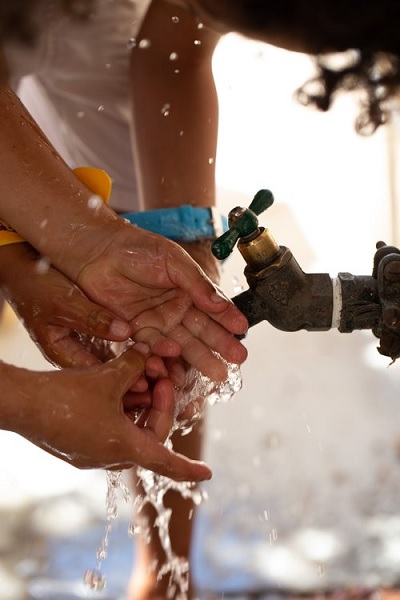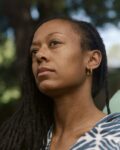
Janna Ireland
American, 1985
Outdoor Faucet, 2020
archival prigment print
30 × 20 in.
SBMA, Museum Purchase, Eric A. Skipsey Acquisition Fund
2021.5.4

Janna Ireland photo (Carlos Jaramillo / For The LA Times)
“Photography, for me, is a way of seeing the world and being comfortable in the world and making myself part of the world. Home is probably the most consistent theme in my work.” – Janna Ireland
COMMENTS
This story, as told to Elisa Wouk Almino, is part of Image issue 11, “Renovation,” where we explore the architecture of everyday life.
When I was growing up, my grandmother lived in L.A. Growing up in the ’90s, it feels like L.A. was so prominent in culture — whether that was for exciting, interesting cultural things or for things like the uprising after the Rodney King verdict or the O.J. Simpson trial. L.A. was always a part of my consciousness. Once I got here, I just continued to fall in love with it, both for the city itself — the way it set up the architecture, the landscape — and for the sense of community that I felt as an artist. Even though I lived in New York for a total of nine years, I found the art community really closed off. But it didn’t feel that way here.
My husband has quite a bit of family here; his mom grew up here, and his grandfather lived in this great big house out in Encino. When my husband and I moved to L.A., we began visiting his grandfather regularly to watch Lakers games and have brunch. I became really interested in the house as a subject. The idea, at first, was photographing myself in the house, and then it was photographing myself as someone who could be living in that house. For me, it was this kind of palace that felt completely disconnected from, say, the house I grew up in in West Philly. In those photographs, I’m pretending to be a person who has this status or power that I don’t have, or that I didn’t have at the time. The work became my MFA thesis project at UCLA, “The Spotless Mirror” (2011-13). After my children were born, I started photographing them there. I was thinking about them as people who were born into the family whose house it was, and who had a really different connection to the place. That project, “Milk and Honey” (2018–ongoing), is about a fantasy version of my family.
Adrian is 6, and David is 4. They are both incredibly energetic, incredibly curious. They’re both so smart and funny. But they’re also really different from each other. Adrian is interested in stories, whether that is on television, whether that’s movies, whether that’s books — his whole thing is listening to and making up stories. David, he’s more like, I could set up a tent for him in the backyard and he would just live out here. He would never ever get bored. He would never need to come into the house. He would just be happy looking for rocks and bugs all day.
The “Family Album” show organized by the Los Angeles County Museum of Art includes four projects of mine, including “Tender Boughs,” which is work that I did at home, beginning during the most isolated part of the pandemic, and that I’m still working on right now. The work is mostly portraits of my children but it also includes isolated gestures. It includes things like toys or little corners of our home. A solo show of “Tender Boughs” is also opening on June 4 at Council St in Historic Filipinotown.
For a long time, I felt that if I was taking pictures at home with my family versus these highly staged and carefully lit and really kind of fantasy versions of family photos, that I might not be taken seriously. I was worried that if I tried to do it, it wouldn’t be interesting to other people. I wanted to focus on my children as they actually are. I wanted to look at their relationship with each other. I’m an only child, and sibling relationships were just endlessly fascinating to me. It became a way to look at the way they played together, the way they love each other and the way that they are kind of growing and changing every day.
I think that having children made me feel a sense of urgency in terms of my own work. It became really important to me to have this other thing. For me to be able to devote all of the mental and physical energy necessary to my children, I also had to be able to always be doing this thing. “Tender Boughs” was work that I made when I was having a really hard time. You know, we were all stuck at home, and I had all of these things that I wanted to be doing that I couldn’t do, or that I had to do in a way that was modified because I had to be at home. And because I had to be looking after the children all the time, the work became this really important distraction for me.
In one of my favorite early photos from the body of work, I am standing on the second floor of the house that we lived in at the time and photographing my children playing in the backyard through the window. There is a way that they can change when my camera comes out, either becoming sillier or becoming more serious. And this photograph was really special to me, because they didn’t know I was there. Another one of my favorite images is my older son giving my younger son a hug. You can’t see their faces completely but you can see that my older son has his brow furrowed. I don’t remember what was going on with him at the moment but he was just feeling everything so deeply, and for whatever reason, it became so important to give his brother this hug …
https://www.latimes.com/lifestyle/image/story/2022-05-18/architectural-photographer-janna-ireland-on-paul-williams-interior-life-art-human-story
Related photos in the “Tender Boughs” collection: https://www.jannaireland.com/tender-boughs
SBMA CURATORIAL LABELS
Janna Ireland took this color-saturated image of her two children washing their hands in her backyard during summer 2020's Covid-19 Iockdown. Ireland's photography often features her family members and investigates ideas of identity, psychology, narrative and place. This photograph came about more spontaneously. Ireland created this image on a specific day and hour because of the particular beauty of the light she observed during her children's daily ritual of washing hands before a meal. Intimate without being sentimental, the photograph is a timely record of an activity the world has been conducting for over
2 1/2 years. Yet this image is also timeless in its evocation of the importance of supporting and sustaining other people in times of crisis and beyond.
- A Time of Gifts, 2022
